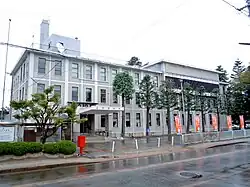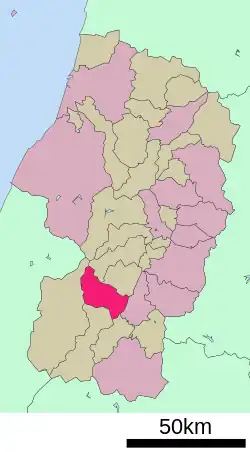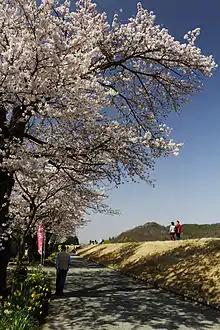Nagai
長井市 | |
|---|---|
 Nagai City Hall | |
 Flag  Seal | |
 Location of Nagai in Yamagata Prefecture | |
 Nagai | |
| Coordinates: 38°6′27″N 140°2′25.9″E / 38.10750°N 140.040528°E | |
| Country | Japan |
| Region | Tōhoku |
| Prefecture | Yamagata |
| Area | |
| • Total | 214.67 km2 (82.88 sq mi) |
| Population (February 2020) | |
| • Total | 26,466 |
| • Density | 120/km2 (320/sq mi) |
| Time zone | UTC+9 (Japan Standard Time) |
| Phone number | 0238-84-2111 |
| Address | 5-1 Mamanoue, Nagai-shi, Yamagata-ken 993-8601 |
| Climate | Cfa/Dfa |
| Website | Official website |
| Symbols | |
| Flower | Iris |
| Tree | Azalea |

Nagai (長井市, Nagai-shi) is a city located in Yamagata Prefecture, Japan. As of 1 February 2020, the city had an estimated population of 26,466 in 9940 households,[1] and a population density of 120 people per km². The total area of the city is 214.67 square kilometres (83 sq mi).
Geography
Nagai is located in mountainous southern Yamagata Prefecture. The Mogami River passes through eastern portion the city, and the northwest end of the city includes Mount Asahi.
Neighboring municipalities
Climate
Nagai has a Humid continental climate (Köppen climate classification Cfa) with large seasonal temperature differences, with warm to hot (and often humid) summers and cold (sometimes severely cold) winters. Precipitation is significant throughout the year, but is heaviest from August to October. The average annual temperature in Nagai is 11.0 °C (51.8 °F). The average annual rainfall is 1,856.5 mm (73.09 in) with September as the wettest month. The temperatures are highest on average in August, at around 23.8 °C (74.8 °F), and lowest in January, at around −0.9 °C (30.4 °F).[2]
| Climate data for Nagai (1991−2020 normals, extremes 1976−present) | |||||||||||||
|---|---|---|---|---|---|---|---|---|---|---|---|---|---|
| Month | Jan | Feb | Mar | Apr | May | Jun | Jul | Aug | Sep | Oct | Nov | Dec | Year |
| Record high °C (°F) | 14.2 (57.6) |
16.4 (61.5) |
20.0 (68.0) |
28.8 (83.8) |
33.4 (92.1) |
34.3 (93.7) |
35.3 (95.5) |
36.9 (98.4) |
35.3 (95.5) |
29.6 (85.3) |
25.7 (78.3) |
17.3 (63.1) |
36.9 (98.4) |
| Mean daily maximum °C (°F) | 2.4 (36.3) |
3.4 (38.1) |
7.3 (45.1) |
14.9 (58.8) |
21.3 (70.3) |
24.7 (76.5) |
27.8 (82.0) |
29.2 (84.6) |
24.8 (76.6) |
18.7 (65.7) |
11.9 (53.4) |
5.3 (41.5) |
16.0 (60.7) |
| Daily mean °C (°F) | −0.9 (30.4) |
−0.6 (30.9) |
2.5 (36.5) |
8.8 (47.8) |
15.1 (59.2) |
19.3 (66.7) |
22.9 (73.2) |
23.8 (74.8) |
19.4 (66.9) |
13.0 (55.4) |
6.7 (44.1) |
1.6 (34.9) |
11.0 (51.7) |
| Mean daily minimum °C (°F) | −4.2 (24.4) |
−4.4 (24.1) |
−1.8 (28.8) |
3.1 (37.6) |
9.2 (48.6) |
14.6 (58.3) |
18.9 (66.0) |
19.5 (67.1) |
15.2 (59.4) |
8.4 (47.1) |
2.4 (36.3) |
−1.5 (29.3) |
6.6 (43.9) |
| Record low °C (°F) | −14.6 (5.7) |
−18.3 (−0.9) |
−13.6 (7.5) |
−6.4 (20.5) |
−0.2 (31.6) |
5.5 (41.9) |
9.6 (49.3) |
10.3 (50.5) |
4.2 (39.6) |
−0.9 (30.4) |
−7.7 (18.1) |
−14.3 (6.3) |
−18.3 (−0.9) |
| Average precipitation mm (inches) | 179.4 (7.06) |
127.0 (5.00) |
120.2 (4.73) |
109.4 (4.31) |
109.4 (4.31) |
141.8 (5.58) |
246.4 (9.70) |
160.2 (6.31) |
139.0 (5.47) |
139.1 (5.48) |
180.4 (7.10) |
204.3 (8.04) |
1,856.5 (73.09) |
| Average snowfall cm (inches) | 260 (102) |
200 (79) |
112 (44) |
9 (3.5) |
0 (0) |
0 (0) |
0 (0) |
0 (0) |
0 (0) |
0 (0) |
5 (2.0) |
140 (55) |
731 (288) |
| Average precipitation days (≥ 1.0 mm) | 23.4 | 19.0 | 17.4 | 13.5 | 11.3 | 11.0 | 14.0 | 11.5 | 11.7 | 13.1 | 17.3 | 22.1 | 185.3 |
| Average snowy days (≥ 3 cm) | 23.1 | 19.4 | 12.9 | 1.2 | 0 | 0 | 0 | 0 | 0 | 0 | 0.6 | 11.8 | 69 |
| Mean monthly sunshine hours | 49.8 | 66.5 | 124.0 | 172.1 | 197.2 | 164.6 | 137.7 | 174.3 | 132.5 | 117.2 | 86.2 | 52.0 | 1,481.3 |
| Source: Japan Meteorological Agency[3][2] | |||||||||||||
Demographics
Per Japanese census data,[4] the population of Nagai has declined over the past 70 years.
| Year | Pop. | ±% |
|---|---|---|
| 1920 | 26,797 | — |
| 1930 | 31,359 | +17.0% |
| 1940 | 32,182 | +2.6% |
| 1950 | 37,429 | +16.3% |
| 1960 | 36,211 | −3.3% |
| 1970 | 33,221 | −8.3% |
| 1980 | 33,286 | +0.2% |
| 1990 | 33,260 | −0.1% |
| 2000 | 31,987 | −3.8% |
| 2010 | 29,476 | −7.9% |
| 2020 | 26,543 | −10.0% |
History
The area of present-day Nagai was part of Dewa Province and was part of the holdings of Yonezawa Domain under the Edo period Tokugawa shogunate. The village of Nagai was created within Nishiokitama District, Yamagata with the establishment of the modern municipalities system on April 1, 1889. Nagai merged with the neighboring villages of Toyoda, Hirano, Nishine and Isazawa on November 15, 1954 to form the city of Nagai.
Government
Nagai has a mayor-council form of government with a directly elected mayor and a unicameral city legislature of 16 members. The city contributes two members to the Yamagata Prefectural Assembly shared with Nishiokitama District. In terms of national politics, the city is part of Yamagata District 2 of the lower house of the Diet of Japan.
Economy
The economy of Nagai is based on agriculture and light manufacturing of electronic and robotic components and pharmaceuticals.
Education
Nagai has six public elementary schools and two public middle schools operated by the city government and two public high schools operated by the Yamagata Prefectural Board of Education.
Transportation
Railway
![]() East Japan Railway Company - Yonesaka Line
East Japan Railway Company - Yonesaka Line
![]() Yamagata Railway Company - Flower Nagai Line
Yamagata Railway Company - Flower Nagai Line
- Imaizumi - Tokiniwa - Minami-Nagai - Nagai - Ayame Kōen - Uzen-Narita - Shirousagi
Highways
International relations
Twin towns — Sister cities
 - Bad Säckingen, Waldshut, Baden-Württemberg, Germany,[5] since May 8, 1983
- Bad Säckingen, Waldshut, Baden-Württemberg, Germany,[5] since May 8, 1983 – Shuangyashan, Heilongjiang, China,[5] since May 21, 1992
– Shuangyashan, Heilongjiang, China,[5] since May 21, 1992
Notable people
- Hirofumi Watanabe, professional soccer player
References
- ↑ Nagai City official statistics (in Japanese)
- 1 2 気象庁 / 平年値(年・月ごとの値). JMA. Retrieved March 25, 2022.
- ↑ 観測史上1~10位の値(年間を通じての値). JMA. Retrieved March 25, 2022.
- ↑ Nagai population statistics
- 1 2 "International Exchange". List of Affiliation Partners within Prefectures. Council of Local Authorities for International Relations (CLAIR). Archived from the original on 4 March 2016. Retrieved 21 November 2015.
External links
- Official Website (in Japanese)